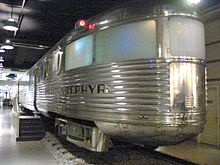Pulpit car
A pulpit car is a rail vehicle that is used at the end of a train and has a viewing compartment there. Derived this is type of vehicle of US Observation Cars - observation car . Today this type of vehicle is mainly used in Japan .
Germany
In the German Federal Railways two such running passenger cars from the summer timetable 1953 in regular service:
- in the pre-war set of the earlier Henschel-Wegmann train used for the “ Blue Enzian ” and
- in the second set prepared for this connection, because one wagon set was not enough for circulation due to the long route . The pulpit car of this train composition was converted in 1950 from the saloon car 10217 of the type Salon4üe-38/50, which in turn was created in 1940 from the Schürzenwagen 19347 of the type C4ü-38. For circulation in the Blauer Enzian it was given the road number 11700 and the generic designation AB4üe-38/50/54. The return train thus also had an end car comparable to the Henschel-Wegmann train.
Both pulpit cars were distinguished by a rounded glass pulpit. The second set was taken out of service in 1956 after the two-class system was switched over, but the Henschel-Wegmann train was able to hold out until 1959.
The pulpit car of the second set is painted cobalt blue again after a period in ivory / ocean blue and is now part of the inventory of the Nuremberg Transport Museum . After a job with the Historic Railway in Frankfurt , he is now back in the care of the DB Museum, Koblenz-Lützel branch.
Austria
Pulpit cars were in use on the Bosnian Eastern Railway before the First World War .
Switzerland
The Montreux-Bernese land track in Switzerland can with the gold Panoramic between Montreux and Zweisimmen a shuttle train run, which has at both ends a pulpit; the driver's cabs are raised like the ETR 300.
Italy
The railcars of the class FS ETR 300 , Settebello and Ferrovie dello Stato (FS) put into service in 1952 had a pulpit car at both ends. So that this was structurally possible, the engine driver was housed in a raised and recessed cabin.
Spain

The Talgo II sets, which can only be driven in one direction, had an end car with a view to the rear at the end of the train. Inside it was set up with loose armchairs. Even the prototype Talgo I, which never went into scheduled service, had a pulpit car at the end.
North America

This type of car was relatively common in the USA and Canada as an observation car . It was and is still used today as the end car on some trains that are more used for tourism. The constructions on Milwaukee Road proved to be particularly striking , for which industrial design special forms such as the “Beavertail Observation” by Otto Kuhler or the “Skytop Lounge” by Brooks Stevens were created. The pulpit carriages of the Skytop Lounge design were easily distinguishable from other shapes, as they were not only rounded, but also sloped towards the roof and fully glazed.
Six railroad companies acquired mixed roof observation pulpit cars from Budd : The Chicago, Burlington and Quincy Railroad , the Denver and Rio Grande Western Railroad and the Western Pacific Railroad used them for their jointly operated California Zephyr and the Canadian Pacific Railway for the Canadian and the Canadian Dominion . The Wabash Railroad used it for their Bluebird from Chicago to St. Louis and the Chesapeake and Ohio Railway provided it for the Chessie , which never went into operation. The C&O cars went to Denver & Rio Grande, where they were used in the Royal Gorge .
Japan
In the Twilight Express , a sleeping car train that ran between Osaka and Sapporo until March 2016 , a particularly luxurious two-bed compartment was offered in the pulpit car.
A number of railway companies operate railcars that have a pulpit at each end. As with the Italian ETR 300, the driver's cabs have been moved upwards.
Sri Lanka
On the Colombo – Badulla railway line, pulpit cars are scheduled to be used in a pair of express trains and mixed trains . They can be used with 1st class tickets.
South Africa
The tour operator Rovos Rail owns pulpit cars, some with an open end platform, which it regularly places in its luxury trains.
literature
- Magistrate of the City of Potsdam [Hrsg.]: Catalog. European saloon car exhibition from May 22nd to 23rd, 1993 on the grounds of Raw Potsdam . Potsdam 1993.
Web links
Individual evidence
- ↑ See catalog. European Salon Car Show , p. 6; Both cars are not to be confused with the driver's observation car .
- ↑ See catalog. European Salon Car Show , p. 6.
- ↑ Archived copy ( Memento of the original dated November 5, 2014 in the Internet Archive ) Info: The archive link was inserted automatically and has not yet been checked. Please check the original and archive link according to the instructions and then remove this notice.
- ↑ Werner Schiendl : The railways in Bosnia and Herzegovina from 1867 to 1918 . Vienna 2015. ISBN 978-3-9503096-5-2 , p. 319 (illustration).
- ↑ Andreas Illert: Take the train at 5:55 a.m. to tea . In: Fern-Express 3/2016, pp. 22-29 (28).




